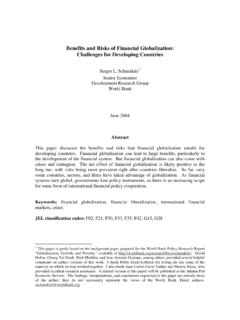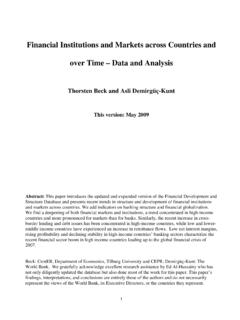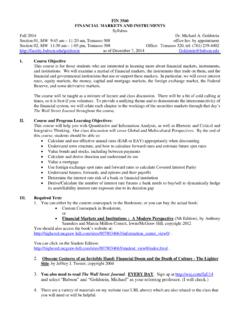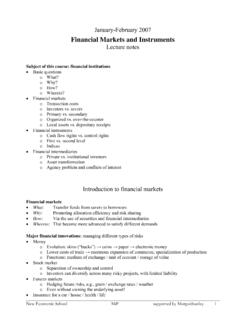Transcription of Part 3. Financial Institutions
1 Notes: FIN 303 Fall 15, part 3 Financial Institutions Professor James P. Dow, Jr. 22 part 3. Financial Institutions This section will introduce you to the major kinds of Financial Institutions . What is a Financial Intermediary? Many Financial Institutions play the role of a Financial intermediary. That is, they help connect borrowers and lenders of funds. We can think of the activities of a Financial intermediary in terms of its balance sheet. Assets Liabilities Obtain funds from investors Provide funds to borrowers Balance Sheet of Financial Intermediary (flow of funds) (flow of funds) Banks and Other Lending Institutions Banks are Financial intermediaries that accept deposits and make loans.
2 Banks offer several advantages in connecting borrows and lenders. By pooling the funds of thousands of different depositors they are able to make large loans beyond the means of any individual investor. In addition, because they deal in such a large volume of loans, their costs to making a loan are smaller than for a single investor. One special kind of cost is information cost. When you make a loan, you want to know the likelihood that the loan will be repaid. This information is difficult to determine for a part -time investor. But banks specialize in making loans and so are better at assessing risk. An additional advantage of banks is that they can make small loans.
3 If you run a small business that needed to borrow $50,000 it would be too costly to issue bonds to raise that small amount. Rather, you would go to a Financial intermediary to obtain the funds. Loans Deposits Investors deposit fund s Bank lends money to borrowers Balance Sheet of Banks Notes: FIN 303 Fall 15, part 3 Financial Institutions Professor James P. Dow, Jr. 23 Banks make a variety of different kinds of loans. They lend money to businesses for capital improvement projects, called commercial and industrial loans. They lend money to consumers for projects such as auto and college loans, called consumer loans, and also to purchase a house, called a real estate loan, or a mortgage.
4 Banks make profits by the spread between the interest rate on the loan that they make and on the deposits that they take. For example, you might have the choice between getting a direct loan at 6% interest or going to a bank. If you went through a bank it might charge 8% for the loan and only pay 5% to the depositors. But because of the services and convenience of going through the bank, borrowers and lenders are willing to do it. The 3% goes to the bank as payment for the services it provides. The banking system in the US has undergone a substantial evolution over the last 50 years. Historically, there has been a distrust of large Financial Institutions in the US, particularly after the collapse of the banking system during the Great Depression.
5 This resulted in a strict regulation of banking practice. Commercial banks were forced to keep out of other business such as insurance or investment banking (the business of assisting firms issuing new securities). Commercial banks were also restricted to having branches in only one state. This resulted in a very fractured banking and Financial system. In recent years this legislation has been repealed, producing a flurry of mergers and expansions. A number of middle and large-sized banks merged to become mega-banks. The banking landscaped has turned to a mix of a large number of very small local banks and a few extremely large banks. The banks also expanded the services they offered to include mutual funds, insurance and investment banking.
6 Credit Unions and Savings Banks Savings banks, savings and loans and credit unions are just other kinds of banks. Their primary business is to take in deposits and make loans. They differ somewhat from standard commercial banks in how they are regulated and their tax treatment. Credit Scoring and Risk Management One of the important decisions made by bank managers is whether or not someone should be offered a loan. The primary consideration is whether the borrower will pay the money bank higher interest rates are of no value to the bank if the loan is not repaid. In the past, loan evaluations were performed by managers at the bank. They would look at a number of different factors that might predict whether the borrower would repay the loan: the borrower s income, their assets, the amount of debt they have, if they have defaulted on a loan before, and so on.
7 This process posed several problems for the bank. It left open the issue of how important was income relative to assets, or other variables; and it was a costly process as it required experienced and skilled bank managers to make each decision. The use of a statistical technique, called credit scoring, combined with computer technology has significantly changed this process. The first step in the credit scoring process is to look at thousands and thousands of previous loans. Statistically, the bank determined which factors Notes: FIN 303 Fall 15, part 3 Financial Institutions Professor James P. Dow, Jr. 24predict the probability of defaulting on a loan.
8 Each factor is assigned points, the more important it is in predicting repayment, the more points it gets. Then, for each individual applying for a loan, each factor is assessed. A total score is assigned, and is used to make a decision on the loan. If a person has a high enough score, they get the loan, otherwise they do not, or they will be hand-screened or offered a different loan. Credit scoring offers several advantages to banks. The first is that by looking at thousands and thousands of past loans, they are able to incorporate knowledge that only an experienced manager would have. Second, once the initial statistical study is done, this is a very low-cost way of evaluating loans; it does not require much human time and does not require specialized managers.
9 Finally, it is very fast. When you apply for a loan, once the information is entered, the bank can make a quick decision, without waiting for a human to go over the files. The cost of this approach is that even a good computer program is not as flexible as a well-trained, experienced manager. There may be cases where an individual is a good credit risk, but will get a low credit score (or visa versa) and the manager would make the correct decision where the computer would not. However, this cost of the credit scoring approach seems to be smaller than the benefits it brings to the banks. Because of this, most large Financial intermediaries incorporate credit scoring, and are quite secretive of their exact program.
10 If they have a better program than others they will have a competitive advantage in the marketplace. Other Financial Intermediaries Mutual Funds One of the difficulties that small investors face is that it can be expensive to construct a well-diversified portfolio. Most brokerages require you to make purchases of a minimum size (although this size limit has fallen dramatically with the advent of internet brokerages). If you only had $1,000 to invest, and you wanted to buy shares in 20 different companies, it would be difficult to do. Also, the cost per share, when buying this number of shares, is much higher than if you could make an order for 10,000 shares.



















